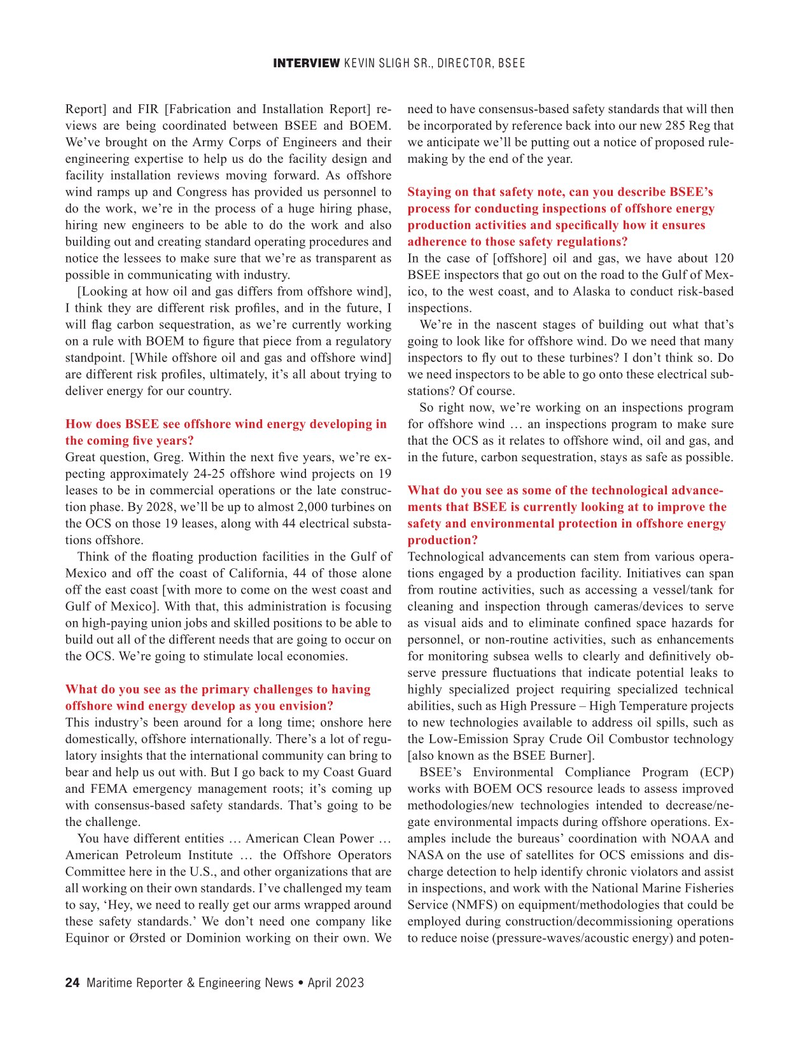
Page 24: of Maritime Reporter Magazine (April 2023)
Cruise Shipping
Read this page in Pdf, Flash or Html5 edition of April 2023 Maritime Reporter Magazine
INTERVIEW KEVIN SLIGH SR., DIRECTOR, BSEE
Report] and FIR [Fabrication and Installation Report] re- need to have consensus-based safety standards that will then views are being coordinated between BSEE and BOEM. be incorporated by reference back into our new 285 Reg that
We’ve brought on the Army Corps of Engineers and their we anticipate we’ll be putting out a notice of proposed rule- engineering expertise to help us do the facility design and making by the end of the year.
facility installation reviews moving forward. As offshore wind ramps up and Congress has provided us personnel to Staying on that safety note, can you describe BSEE’s do the work, we’re in the process of a huge hiring phase, process for conducting inspections of offshore energy hiring new engineers to be able to do the work and also production activities and speci? cally how it ensures building out and creating standard operating procedures and adherence to those safety regulations?
notice the lessees to make sure that we’re as transparent as In the case of [offshore] oil and gas, we have about 120 possible in communicating with industry. BSEE inspectors that go out on the road to the Gulf of Mex- [Looking at how oil and gas differs from offshore wind], ico, to the west coast, and to Alaska to conduct risk-based
I think they are different risk pro? les, and in the future, I inspections. will ? ag carbon sequestration, as we’re currently working We’re in the nascent stages of building out what that’s on a rule with BOEM to ? gure that piece from a regulatory going to look like for offshore wind. Do we need that many standpoint. [While offshore oil and gas and offshore wind] inspectors to ? y out to these turbines? I don’t think so. Do are different risk pro? les, ultimately, it’s all about trying to we need inspectors to be able to go onto these electrical sub- deliver energy for our country. stations? Of course.
So right now, we’re working on an inspections program
How does BSEE see offshore wind energy developing in for offshore wind … an inspections program to make sure the coming ? ve years? that the OCS as it relates to offshore wind, oil and gas, and
Great question, Greg. Within the next ? ve years, we’re ex- in the future, carbon sequestration, stays as safe as possible.
pecting approximately 24-25 offshore wind projects on 19 leases to be in commercial operations or the late construc- What do you see as some of the technological advance- tion phase. By 2028, we’ll be up to almost 2,000 turbines on ments that BSEE is currently looking at to improve the the OCS on those 19 leases, along with 44 electrical substa- safety and environmental protection in offshore energy tions offshore. production?
Think of the ? oating production facilities in the Gulf of Technological advancements can stem from various opera-
Mexico and off the coast of California, 44 of those alone tions engaged by a production facility. Initiatives can span off the east coast [with more to come on the west coast and from routine activities, such as accessing a vessel/tank for
Gulf of Mexico]. With that, this administration is focusing cleaning and inspection through cameras/devices to serve on high-paying union jobs and skilled positions to be able to as visual aids and to eliminate con? ned space hazards for build out all of the different needs that are going to occur on personnel, or non-routine activities, such as enhancements the OCS. We’re going to stimulate local economies. for monitoring subsea wells to clearly and de? nitively ob- serve pressure ? uctuations that indicate potential leaks to
What do you see as the primary challenges to having highly specialized project requiring specialized technical offshore wind energy develop as you envision? abilities, such as High Pressure – High Temperature projects
This industry’s been around for a long time; onshore here to new technologies available to address oil spills, such as domestically, offshore internationally. There’s a lot of regu- the Low-Emission Spray Crude Oil Combustor technology latory insights that the international community can bring to [also known as the BSEE Burner].
bear and help us out with. But I go back to my Coast Guard BSEE’s Environmental Compliance Program (ECP) and FEMA emergency management roots; it’s coming up works with BOEM OCS resource leads to assess improved with consensus-based safety standards. That’s going to be methodologies/new technologies intended to decrease/ne- the challenge. gate environmental impacts during offshore operations. Ex-
You have different entities … American Clean Power … amples include the bureaus’ coordination with NOAA and
American Petroleum Institute … the Offshore Operators NASA on the use of satellites for OCS emissions and dis-
Committee here in the U.S., and other organizations that are charge detection to help identify chronic violators and assist all working on their own standards. I’ve challenged my team in inspections, and work with the National Marine Fisheries to say, ‘Hey, we need to really get our arms wrapped around Service (NMFS) on equipment/methodologies that could be these safety standards.’ We don’t need one company like employed during construction/decommissioning operations
Equinor or Ørsted or Dominion working on their own. We to reduce noise (pressure-waves/acoustic energy) and poten- 24 Maritime Reporter & Engineering News • April 2023
MR #4 (18-33).indd 24 4/5/2023 6:02:46 PM

 23
23

 25
25
